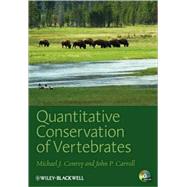Quantitative Conservation of Vertebrates

Quantitative Conservation of Vertebrates
- ISBN 13:
9781405182287
- ISBN 10:
1405182288
- Edition: 1st
- Format: Paperback
- Copyright: 01/27/2009
- Publisher: Wiley-Blackwell
New From $123.50
Sorry, this item is currently unavailable on Knetbooks.com
List Price $124.74 Save $1.24
New
$123.50
Print on Demand: 2-4 Weeks. This item cannot be cancelled or returned.
We Buy This Book Back!
Included with your book
Free Shipping On Every Order
Note: Supplemental materials are not guaranteed with Rental or Used book purchases.
Extend or Purchase Your Rental at Any Time
Need to keep your rental past your due date? At any time before your due date you can extend or purchase your rental through your account.
Summary
This book provides a hands-on introduction to the construction and application of models to studies of vertebrate distribution, abundance, and habitat. The book is aimed at field biologists, conservation planners, and advanced undergraduate and postgraduate students who are involved with planning and analyzing conservation studies, and applying the results to conservation decisions. The book also acts as a bridge to more advanced and mathematically challenging coverage in the wider literature.Part I provides a basic background in population and community modeling. It introduces statistical models, and familiarizes the reader with important concepts in the design of monitoring and research programs. These programs provide the essential data that guide conservation decision making. Part II covers the principal methods used to estimate abundance, occupancy, demographic parameters, and community parameters, including occupancy sampling, sample counts, distance sampling, and capture-mark-recapture (for both closed and open populations). Emphasis is placed on practical aspects of designing and implementing field studies, and the proper analysis of data. Part III introduces structured decision making and adaptive management, in which predictive models are used to inform conservation decision makers on appropriate decisions in the face of uncertainty-with the goal of reducing uncertainty through monitoring and research. A detailed case study is used to illustrate each of these themes.Numerous worked examples and accompanying electronic material (on a website and accompanying CD) provide the details of model construction and application, and data analysis.








